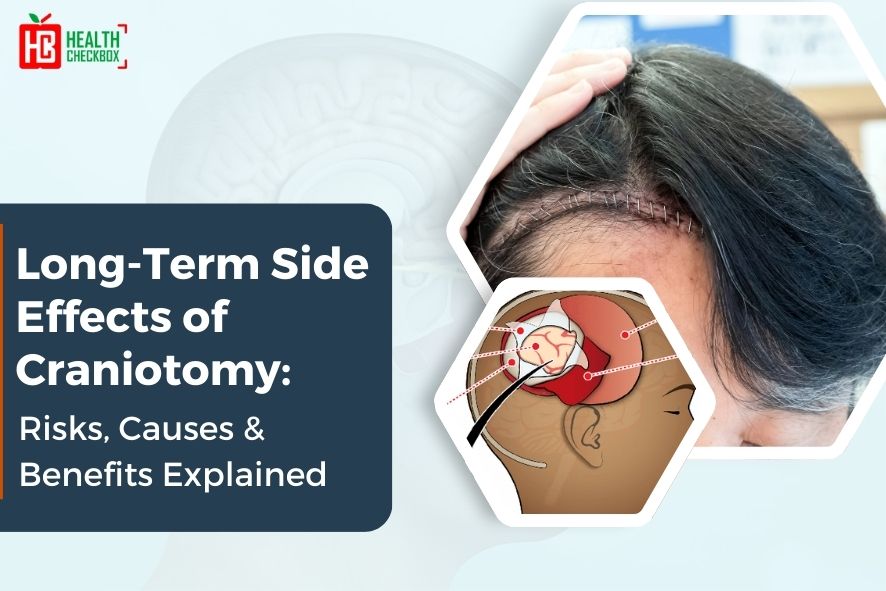A neurological surgery in which a part of the skull is removed temporarily is a craniotomy. This is done to reach the brain and to treat the issues or diseases related to the brain. It is one of the most complex and sensitive surgeries. However, this surgery can save the lives of people dealing with brain hemorrhage, brain cancer, brain tumour, and other diseases related to the brain. Patients and their family members must be aware of the long-term side effects of craniotomy.
What is Craniotomy?
Before exploring the long-term effects of craniotomy, it is important to understand the procedure of craniotomy in detail.
- At first, neurosurgeons create an opening in the skull as per the requirement.
- The size of the cut and incision depends on the condition of the patient.
- It can take several months to recover.
- Some effects can be permanent.
- Severe complications are very rare; most of the patients recover positively.
Long-Term Side Effects of Craniotomy
There can be multiple long-term side effects of craniotomy. A few side effects can stay for a shorter time, while some stay for a longer time. So following are some major long-term side effects that can affect your health in a long way:
Cognitive and Memory Changes
Cognitive functions are one of the most significant long-term concerns:
- Short-Term Memory: It’s hard to remember the regular talks, conversations, dates, or something that happened recently.
- Mental Fog: Lowering the sharpness of mind and processing power.
- Difficulty in Focus: Loss of focus on any work for a longer period.
- Complex Task Impairment: Following multiple instructions at the same time, struggling with financial management.
- Trouble in Execution: Struggling in planning or organizing something.
- Reduced Mental Flexibility: Poor ability to adapt to a new task or a new environment.
Seizures and Epilepsy
Seizure after Carniotomy is another major complication:
- Seen in 10-50% cases, but depends on the surgery.
- It can appear immediately after surgery, or appear weeks or years later.
- Higher risk in a patient who already had a surgery related to the brain.
- It may be seen in patients who have never had a seizure before.
- A long-term medication is required to treat this.
- Side effects of medications may include fatigue or dizziness.
Chronic Headaches
One of the most common long-term side effects is regular and severe headaches:
- Feel of tightness and pressure around the head.
- Sensitive to light and sound, a sign of migraines.
- Pain in the part of the skull from which it is removed.
- Trouble lying on the incisioned side or difficulty in wearing a cap or hat.
- Certain syndromes may require additional therapies and medications for pain.
Physical and Motor Impairments
The patient may have lasting motor deficits, depending on the area of the brain that is accessed:
- Problem in coordinating with others, especially in physical activities, including movement.
- If the cerebellum or nearby parts are involved, a disturbance in balance.
- Weakness in one side of the body, including the legs and arms.
- Difference in walking pattern, also known as gait abnormalities.
- Difficulty in physical movements like writing, using a spoon, or buttoning clothes.
- High chance of falling, may require a supporting device if necessary.
Sensory Changes
Sensory loss for long-term may affect daily life:
- Numbness in the scalp, where the incision is done, and the nerves are being cut.
- A tingling sensation in various parts of the body.
- Troubling in sensing cold and hot things.
- Perception of sensing pain either increases or decreases.
- Difficulty with eye movements, blurry or double vision.
- Peripheral numbness, no feeling or sensation in the feet or palms.
Emotional and Personality Changes
Craniotomy can also affect the person psychologically as below:
- In almost 50% patients, depression is identified.
- Panic attacks and anxiety disorders may arise.
- Rapid emotional mood changes.
- More sensitive to emotions.
- Easily laughing and crying than earlier.
- Acting without thinking about the consequences.
- Low interest in social things and gatherings.
- One can get angry or frustrated easily.
- When the frontal lobes are involved, personality changes.
Fatigue and Sleep Disturbances
Carniotomy can easily impact the energy and sleep issues:
- Consistent tiredness that can’t be healed through rest.
- Can’t perform any activity for a long period of time.
- Troubling in falling asleep, or can’t sleep at night.
- Weird sleep patterns, awaken in the night several times.
- Excessive urge to sleep in the daytime.
- Sleep quality declines even after sleeping for adequate hours.
- Facing difficulty in going back to work or maintaining social relationships.
Difficulties in Speech and Communication
- Facing difficulties in speaking or identifying the language:
- Expressive aphasia is a condition in which a person finds it difficult to find words or form sentences.
- Troubling with writing and speaking a language, receptive aphasia.
- Difficulty in finding words or specific words in a paragraph.
- Facing challenges while speaking or writing.
- Impaired literacy skills may pose challenges in reading and writing.
- Frustration due to communication difficulties and learning the language.
Cosmetic Concerns
There could be psychological effects due to the physical changes in the skull:
- Incision marks often leave scars.
- Shape changes where the part of the skull is removed or replaced.
- Hair loss in the incision area for the lifetime, known as alopecia.
- Asymmetry in the skull or bump.
- Due to a change in physical appearance, self-esteem falls.
Metabolic and Hormonal Changes
When surgery affects the pituitary gland or hypothalamus:
- Thyroid hormones, growth hormone, or cortisol may be deficient and cause a hormonal imbalance.
- Excessive urge to thirst and urination due to diabetes.
- Weight may rise or fall unexpectedly.
- The body struggles to maintain the proper temperature.
- Endocrine dysfunction may require hormone replacement therapy.
Infection and Bone Flap Complications
A structural problem may arise, which could be long-term:
- Infection at the surgical site.
- Bone flap, improper integration of skull bone.
- In some situations, there could be a requirement for re-surgery or replacing the bone flap.
- Leakage of the cerebrospinal fluid may also require another surgery.
Risk Factors Affecting Long-Term Outcomes
Multiple factors can affect in long term:
- Location of surgery in the skull matters, as the parietal, temporal, frontal, or occipital regions each carry different risks.
- Conditions like epilepsy, aneurysm, tumor, and trauma.
- The age of patients matters as the younger patients often recover faster than the older ones.
- Any past medical history can complicate the outcomes.
- Infection, bleeding, or stroke during the surgery or after surgery.
- The extensive the procedure of surgery, the higher the risk of complications later.
Management and Support Strategies
Patients experiencing long-term effects should pursue comprehensive care:
- Don’t skip or avoid any follow-up meetings with your neurologist.
- Take services like physiotherapy and speech therapy if required.
- An evaluation by a neuropsychologist recommends starting the strategy.
- Consult with a pain specialist to minimise the pain.
- Take therapies for anxiety or depression if required.
- Explore and connect with people who may have the same experience.
- Medication plan to treat symptoms like seizures and pain.
- Managing the home, social, and work activities as needed.
- Using diagnostic tools and equipment during the recovery period.
- Help the closed one understand the recovery process.
Conclusion
Understanding the potential long-term side effects of craniotomy is very important for decision-making for most result-driven outcomes. Although there is a chance of risk but it varies depending on various factors. Many patients achieve excellent outcomes. Good planning for surgery, good communication with the healthcare team, and careful aftercare can minimise most of the risk of side effects.

